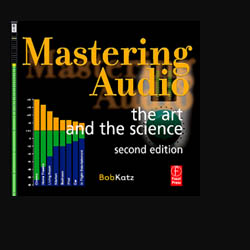
The Myth of the Magic Clip Removal
If the level is turned down by as little as 0.1 dB, then a recording which may be full of OVERs will no longer measure any overs.
But this does not get rid of the clipping or the distortion, it merely prevents it from triggering the meter.
Some mastering engineers deliberately clip the signal severely, and then drop the level slightly, so that the meters will not show any OVERs.
This practice, known as SHRED, produces very fatiguing (and potentially boringly similar) recordings.
Peak Level Practice for Good 24-bit Recording
Even though 24-bit recording is now the norm, some engineers retain the habit of trying to hit the top of the meters, which is totally unnecessary as illustrated at left.
Note that a 16-bit recording fits entirely in the bottom 91 dB of the 24-bit. You would have to lower the peak level of a 24-bit recording by 48 dB to yield an effective 16-bit recording! There is a lot of room at the bottom, so you won’t lose any dynamic range if you peak to -3 dBFS or even as low as -10 dBFS, and you’ll end up with a cleaner recording.
Since distortion accumulates, if a “hot” recording arrives for mastering, the mastering engineer doing analog processing may have to attenuate the level to prevent the processing DAC from overloading. A digital mix that peaks to -3 dBFS or lower makes it easier to equalize and otherwise process without needing an extra stage of attenuation in the mastering.

A number of 24-bit ADCs are advertised as having additional headroom, achieved by employing a built-in compressor at the top of the scale, claiming that the compressor can also protect the ADC from accidental overloads. But this is specious advertising.
Level accidents don’t occur in a mix studio; engineers have control over their levels and when tracking live musicians, it is better to turn off the ADC’s compressor, drop the level and leave plenty of headroom for peaks. The only possible use of this function of a compressor is if you like its sonic qualities and are trying to emulate the sound of tracking to analog tape.
But since tracking decisions are not reversible, I suggest postponing “analog simulation” to the mixing stage. It’s easier to add warmth later than try to take away some mushiness due to an overdriven compressor. As we have just seen, there is no audible improvement in SNR by maximizing a 24-bit recording and no SNR advantage to compressing levels with a good 24-bit ADC.
